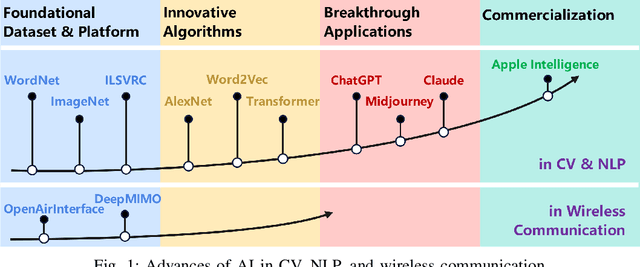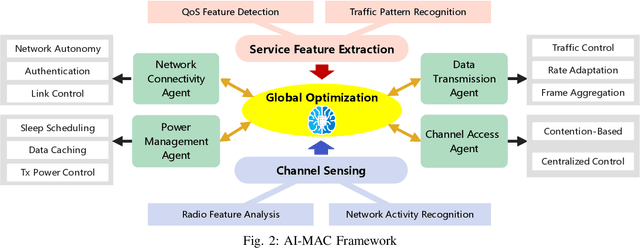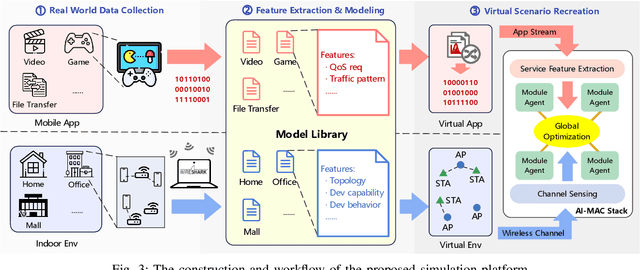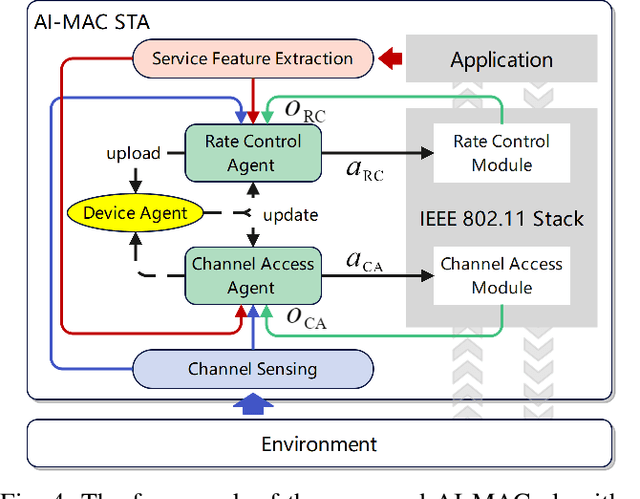Jingqing Wang
Continuous-Aperture Array Based OAM High-Capacity Communication For Metaverse
Feb 12, 2025Abstract:The extensive data interaction demands of an immersive metaverse necessitate the adoption of emerging technologies to enable high-capacity communication. Vortex electromagnetic waves with different orbital angular momentum (OAM) modes are spatially orthogonal, providing a novel spatial multiplexing dimension to achieve high-capacity communication. However, the number of orthogonal OAM modes based on a discrete uniform circular array (UCA) is limited by the number of array elements in the UCA, and traditional discrete channel models are unable to accurately capture the physical properties of vortex electromagnetic wave propagation. The continuous-aperture array (CAPA) is composed of densely packed electromagnetic excitation elements, capable of flexibly and efficiently generating the desired surface currents to produce an arbitrary number of mutually orthogonal OAM modes. From the perspective of electromagnetic information theory (EIT), we propose a CAPA-based OAM orthogonal transmission scheme to realize high-capacity communication. We design the surface currents of the CAPA using Fourier basis functions, derive the electromagnetic channel for vortex electromagnetic waves, and investigate the upper bound of the spectrum efficiency for CAPA-based OAM orthogonal transmission. This paper establishes a theoretical foundation for applying EIT to the orthogonal transmission of vortex electromagnetic waves, offering a novel solution for achieving CAPA-based efficient and high-capacity communication.
Digital-Analog Transmission based Emergency Semantic Communications
Jan 03, 2025



Abstract:Emergency Wireless Communication (EWC) networks adopt the User Datagram Protocol (UDP) to transmit scene images in real time for quickly assessing the extent of the damage. However, existing UDP-based EWC exhibits suboptimal performance under poor channel conditions since UDP lacks an Automatic Repeat reQuest (ARQ) mechanism. In addition, future EWC systems must not only enhance human decisionmaking during emergency response operations but also support Artificial Intelligence (AI)-driven approaches to improve rescue efficiency. The Deep Learning-based Semantic Communication (DL-based SemCom) emerges as a robust, efficient, and taskoriented transmission scheme, suitable for deployment in UDP based EWC. Due to the constraints in hardware capabilities and transmission resources, the EWC transmitter is unable to integrate sufficiently powerful NN model, thereby failing to achieve ideal performance under EWC scene. For EWC scene, we propose a performance-constrained semantic coding model, which considers the effects of the semantic noise and the channel noise. Then, we derive Cramer-Rao lower bound of the proposed semantic coding model, as guidance for the design of semantic codec to enhance its adaptability to semantic noise as well as channel noise. To further improve the system performance, we propose Digital-Analog transmission based Emergency Semantic Communication (DAESemCom) framework, which integrates the analog DL-based semantic coding and the digital Distributed Source Coding (DSC) schemes to leverage their respective advantages. The simulation results show that the proposed DA-ESemCom framework outperforms the classical Separated Source-Channel Coding (SSCC) and other DL-based Joint Source-Channel Coding (DL-based JSCC) schemes in terms of fidelity and detection performances.
MAC Revivo: Artificial Intelligence Paves the Way
Oct 21, 2024



Abstract:The vast adoption of Wi-Fi and/or Bluetooth capabilities in Internet of Things (IoT) devices, along with the rapid growth of deployed smart devices, has caused significant interference and congestion in the industrial, scientific, and medical (ISM) bands. Traditional Wi-Fi Medium Access Control (MAC) design faces significant challenges in managing increasingly complex wireless environments while ensuring network Quality of Service (QoS) performance. This paper explores the potential integration of advanced Artificial Intelligence (AI) methods into the design of Wi-Fi MAC protocols. We propose AI-MAC, an innovative approach that employs machine learning algorithms to dynamically adapt to changing network conditions, optimize channel access, mitigate interference, and ensure deterministic latency. By intelligently predicting and managing interference, AI-MAC aims to provide a robust solution for next generation of Wi-Fi networks, enabling seamless connectivity and enhanced QoS. Our experimental results demonstrate that AI-MAC significantly reduces both interference and latency, paving the way for more reliable and efficient wireless communications in the increasingly crowded ISM band.
RIS-Based Self-Interference Cancellation for Full-Duplex Broadband Transmission
Jul 17, 2024



Abstract:Full-duplex (FD) is an attractive technology that can significantly boost the throughput of wireless communications. However, it is limited by the severe self-interference (SI) from the transmitter to the local receiver. In this paper, we propose a new SI cancellation (SIC) scheme based on reconfigurable intelligent surface (RIS), where small RISs are deployed inside FD devices to enhance SIC capability and system capacity under frequencyselective fading channels. The novel scheme can not only address the challenges associated with SIC but also improve the overall performance. We first analyze the near-field behavior of the RIS and then formulate an optimization problem to maximize the SIC capability by controlling the reflection coefficients (RCs) of the RIS and allocating the transmit power of the device. The problem is solved with alternate optimization (AO) algorithm in three cases: ideal case, where both the amplitude and phase of each RIS unit cell can be controlled independently and continuously, continuous phases, where the phase of each RIS unit cell can be controlled independently, while the amplitude is fixed to one, and discrete phases, where the RC of each RIS unit cell can only take discrete values and these discrete values are equally spaced on the unit circle. For the ideal case, the closed-form solution to RC is derived with Karush-Kuhn-Tucker (KKT) conditions. Based on Riemannian conjugate gradient (RCG) algorithm, we optimize the RC for the case of continuous phases and then extend the solution to the case of discrete phases by the nearest point projection (NPP) method. Simulation results are given to validate the performance of our proposed SIC scheme.
Scalable Extraction Based Semantic Communication for 6G Wireless Networks
Jul 16, 2024



Abstract:Due to the challenges of satisfying the demands for communication efficiency and intelligent connectivity, sixth-generation (6G) wireless network requires new communication frameworks to enable effective information exchange and the integrated Artificial Intelligence (AI) and communication. The Deep Learning (DL) based semantic communication, which can integrate application requirements and the data meanings into data processing and transmission, is expected to become a new paradigm in 6G wireless networks. However, existing semantic communications frameworks rely on sending full semantic feature, which can maximize the semantic fidelity but fail to achieve the efficient semantic communications. In this article, we introduce a novel Scalable Extraction based Semantic Communication (SE-SC) model to support the potential applications in 6G wireless networks and then analyze its feasibility. Then, we propose a promising the SE-SC framework to highlight the potentials of SE-SC model in 6G wireless networks. Numerical results show that our proposed SE-SC scheme can offer an identical Quality of Service (QoS) for the downstream task with much fewer transmission symbols than the full semantic feature transmission and the traditional codec scheme. Finally, we discuss several challenges for further investigating the scalable extraction based semantic communications.
Generative AI Driven Task-Oriented Adaptive Semantic Communications
Jul 16, 2024



Abstract:Task-Oriented Semantic Communication (TOSC) has been regarded as a promising communication framework, serving for various Artificial Intelligence (AI) task driven applications. The existing TOSC frameworks focus on extracting the full semantic features of source data and learning low-dimensional channel inputs to transmit them within limited bandwidth resources. Although transmitting full semantic features can preserve the integrity of data meaning, this approach does not attain the performance threshold of the TOSC. In this paper, we propose a Task-oriented Adaptive Semantic Communication (TasCom) framework, which aims to effectively facilitate the execution of AI tasks by only sending task-related semantic features. In the TasCom framework, we first propose a Generative AI (GAI) architecture based Generative Joint Source-Channel Coding (G-JSCC) for efficient semantic transmission. Then, an Adaptive Coding Controller (ACC) is proposed to find the optimal coding scheme for the proposed G-JSCC, which allows the semantic features with significant contributions to the AI task to preferentially occupy limited bandwidth resources for wireless transmission. Furthermore, we propose a generative training algorithm to train the proposed TasCom for optimal performance. The simulation results show that the proposed TasCom outperforms the existing TOSC and traditional codec schemes on the object detection and instance segmentation tasks at all considered channel conditions.
Dynamic Energy-Saving Design for Double-Faced Active RIS Assisted Communications with Perfect/Imperfect CSI
Jun 12, 2024



Abstract:Although the emerging reconfigurable intelligent surface (RIS) paves a new way for next-generation wireless communications, it suffers from inherent flaws, i.e., double-fading attenuation effects and half-space coverage limitations. The state-of-the-art double-face active (DFA)-RIS architecture is proposed for significantly amplifying and transmitting incident signals in full-space. Despite the efficacy of DFA-RIS in mitigating the aforementioned flaws, its potential drawback is that the complex active hardware also incurs intolerable energy consumption. To overcome this drawback, in this paper we propose a novel dynamic energy-saving design for the DFA-RIS, called the sub-array based DFA-RIS architecture. This architecture divides the DFA-RIS into multiple sub-arrays, where the signal amplification function in each sub-array can be activated/deactivated dynamically and flexibly. Utilizing the above architecture, we develop the joint optimization scheme based on transmit beamforming, DFA-RIS configuration, and reflection amplifier (RA) operating pattern to maximize the energy efficiency (EE) of the DFA-RIS assisted multiuser MISO system considering the perfect/imperfect channel state information (CSI) case. Then, the penalty dual decomposition (PDD) based alternating optimization (AO) algorithm and the constrained stochastic majorization-minimization (CSMM) based AO algorithm address non-convex problems in the perfect/imperfect CSI case, respectively. Simulation results verified that our proposed sub-array based DFA-RIS architecture can benefit the EE of the system more than other RIS architectures.
Self-Sustainable Active Reconfigurable Intelligent Surfaces for Anti-Jamming in Wireless Communications
Jun 12, 2024Abstract:Wireless devices can be easily attacked by jammers during transmission, which is a potential security threat for wireless communications. Active reconfigurable intelligent surface (RIS) attracts considerable attention and is expected to be employed in anti-jamming systems for secure transmission to significantly enhance the anti-jamming performance. However, active RIS introduces external power load, which increases the complexity of hardware and restricts the flexible deployment of active RIS. To overcome these drawbacks, we design a innovative self-sustainable structure in this paper, where the active RIS is energized by harvesting energy from base station (BS) signals through the time dividing based simultaneous wireless information and power transfer (TD-SWIPT) scheme. Based on the above structure, we develop the BS harvesting scheme based on joint transmit and reflecting beamforming with the aim of maximizing the achievable rate of active RIS-assisted system, where the alternating optimization (AO) algorithm based on stochastic successive convex approximation (SSCA) tackles the nonconvex optimization problem in the scheme. Simulation results verified the effectiveness of our developed BS harvesting scheme, which can attain higher anti-jamming performance than other schemes when given the same maximum transmit power.
Movable Antenna Assisted OAM Wireless Communications With Misaligned Transceiver
Jun 09, 2024Abstract:The vortex electromagnetic wave carried by multiple orthogonal orbital angular momentum (OAM) modes in the same frequency band can be applied to the field of wireless communications, which greatly increases the spectrum efficiency. The uniform circular array (UCA) is the classical structure to generate and receive vortex electromagnetic waves with multiple OAM-modes. However, when the transmit and receive UCAs are misaligned, there will be interference among the OAM-modes and the signal cannot be recovered at the receiver. In order to solve this problem, we propose movable antenna (MA) assisted OAM wireless communications scheme. We estimate the rotation angle between transmit and receive UCAs and feed it back to the transmitter. Then, the MA at the transmitter adjusts the rotation angle to achieve alignment of the UCA at both the receiver and transmitter. Simulation results show that our scheme can significantly improve the spectrum efficiency.
Achieving High Capacity Transmission With N-Dimensional Quasi-Fractal UCA
Jun 09, 2024Abstract:The vortex electromagnetic wave carried by multiple orthogonal orbital angular momentum (OAM) modes in the same frequency band can be applied to the field of wireless communications, which greatly increases the spectrum efficiency. The uniform circular array (UCA) is widely used to generate and receive vortex electromagnetic waves with multiple OAM-modes. However, the maximum number of orthogonal OAM-modes based on UCA is usually limited to the number of array-elements of the UCA antenna, leaving how to utilize more OAM-modes to achieve higher channel capacity with a fixed number of arrayelements as an intriguing question. In this paper, we propose an N-dimensional quasi-fractal UCA (ND QF-UCA) antenna structure in different fractal geometry layouts to break through the limits of array-elements number on OAM-modes number. We develop the N-dimensional OAM modulation (NOM) and demodulation (NOD) schemes for OAM multiplexing transmission with the OAM-modes number exceeding the array-elements number, which is beyond the traditional concept of multiple antenna based wireless communications. Then, we investigate different dimensional multiplexing transmission schemes based on the corresponding QF-UCA antenna structure with various array-element layouts and evaluate the optimal layout type and dimension to obtain the highest channel capacity with a fixed number of array-elements. Simulation results show that our proposed schemes can obtain a higher spectrum efficiency, surpassing those of alternative array-element layouts of QF-UCA and the traditional multiple antenna systems.
 Add to Chrome
Add to Chrome Add to Firefox
Add to Firefox Add to Edge
Add to Edge